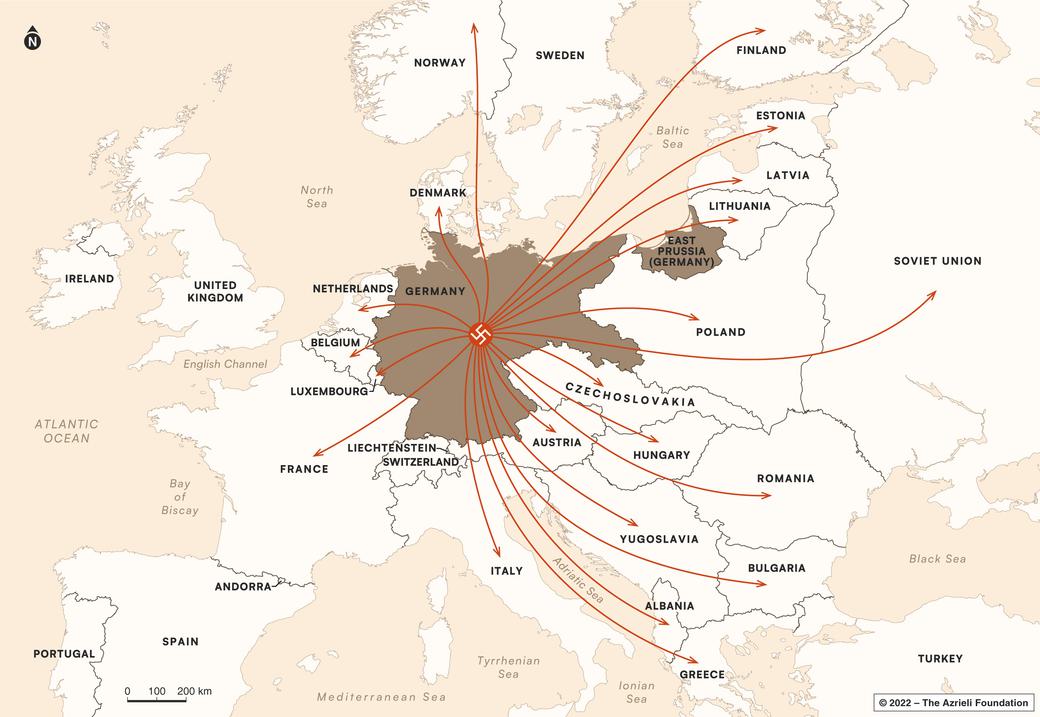
Poland
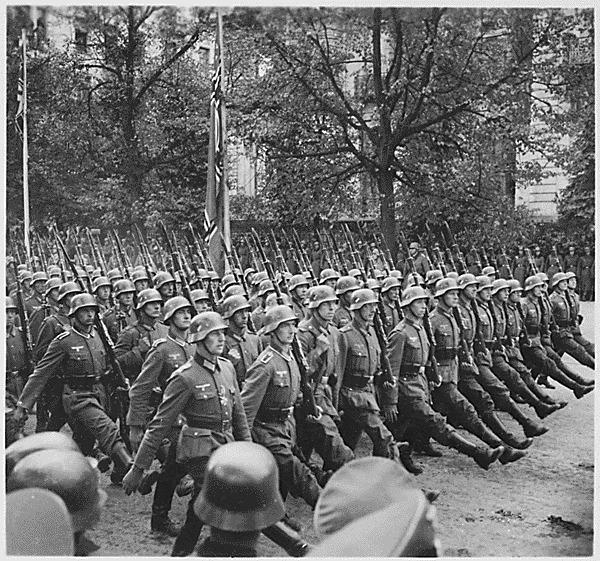
In September 1939, the German army occupies western and central Poland.
“It was a sunny day in ‘golden autumn,’ as we called the season in Poland, when we heard the sound of heavy aircraft. The roar of engines was unusually loud and menacing. We all ran outside the house to look at the sky. Suddenly, darkness spread over us. I felt wrapped in a thick, smoky black cloud…. German troops, who appeared to me to be all the same height, marched triumphantly toward Warsaw, singing.”
German troops march through Warsaw, Poland.
National Archives at College Park, College Park, MD.
Hungary

In March 1944, German forces occupy Hungary, their former ally.
“Our lives immediately and profoundly changed on March 19, 1944…Matters proceeded with lightning speed. Shortly after the German occupation, all Jewish schools had to close their doors. My memories of that time are of constantly worried faces and whispered discussions among the adults around us. The children absorbed their grave concerns by osmosis, and our childhoods were not allowed to blossom as we lived with uncertainty from day to day.”
A roundup of Jews in Budapest by the Hungarian Arrow Cross Party, with the assistance of German police and SS, 1944–1945.
Bundesarchiv, Bild 101I-680-8285A-26 / Faupel.
Germany
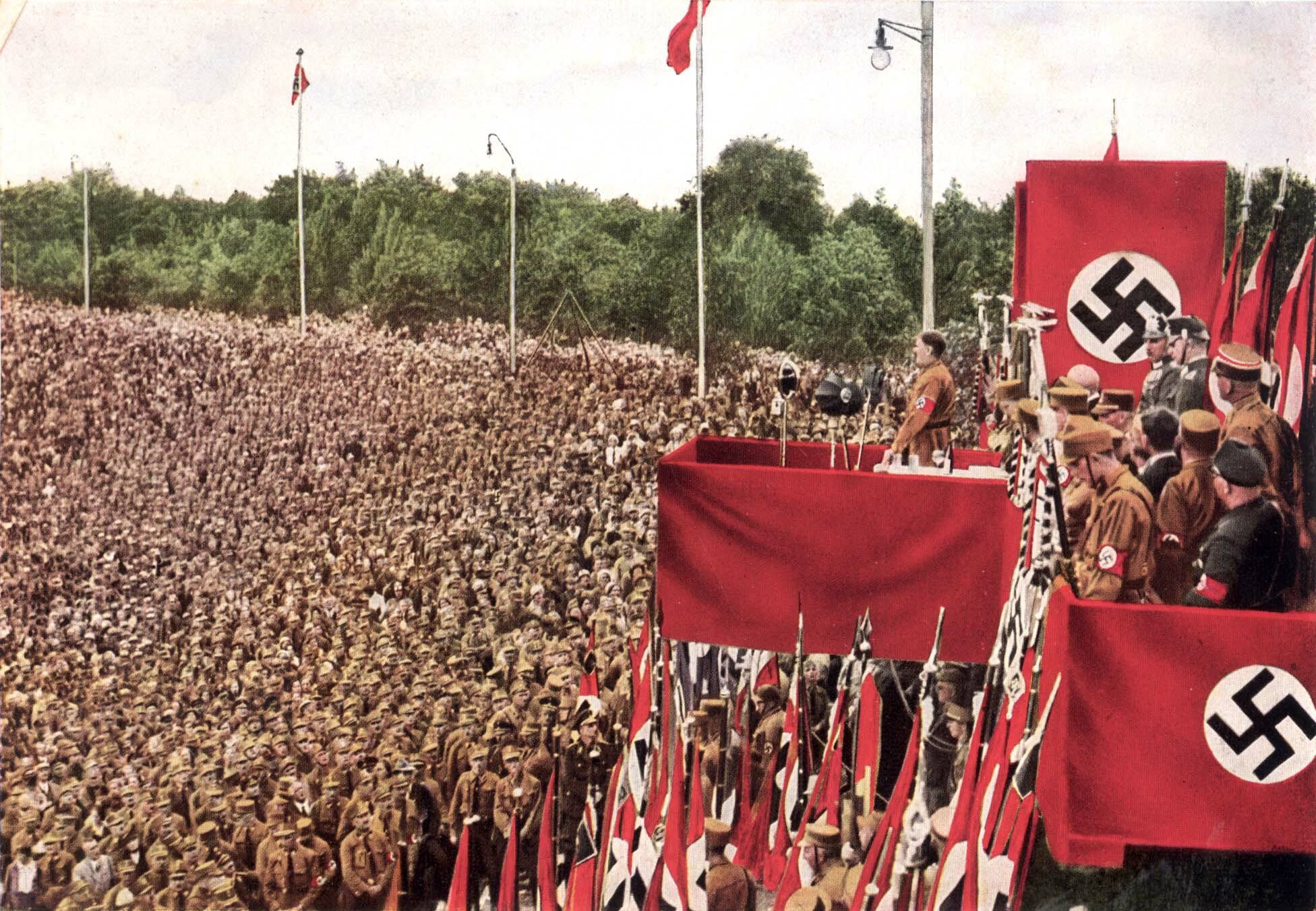
In January 1933, Adolf Hitler is appointed head of the German government. In the following months, Hitler and the Nazi Party begin to gain control of Germany through an election and the passing of governmental decrees.
“However, the Nazis did make it to power in 1933. I remember vividly the elections and the Ja (Yes) vote for the Nazis. Nearly everyone on the street sported a glittering silver or brass swastika pin marked with a Ja on their jackets or garments. Since I was one of the very few who was not wearing the Ja pin of national unity and purpose, I stood out. I felt like a stranger in the country in which I was born…”
Hitler watches a procession of the Nazi Party’s armed division, known as the SA Brownshirts or Stormtroopers, in Germany in 1933.
Yad Vashem Photo Archives, Jerusalem. 46765
France
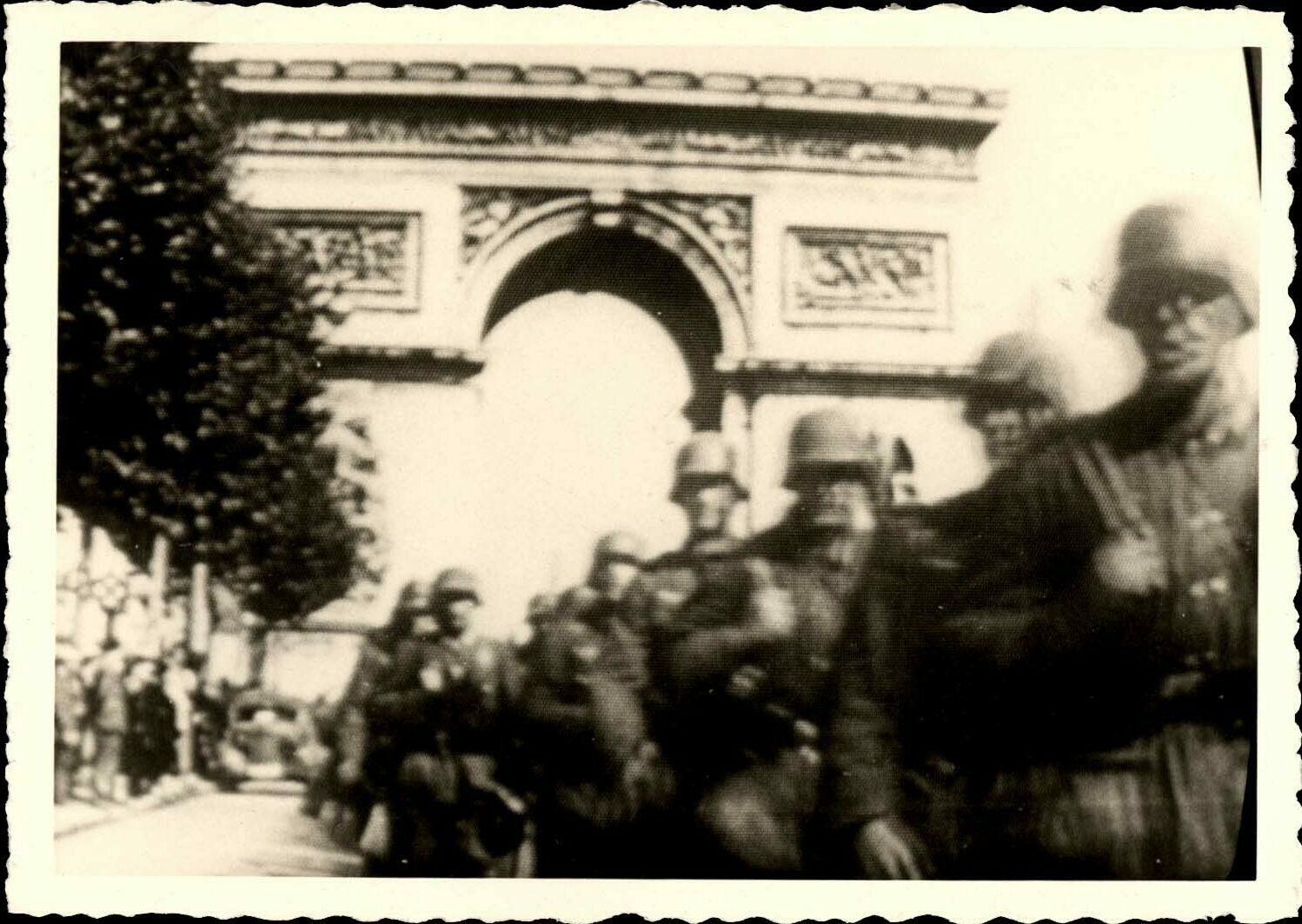
In June 1940, Germany occupies northern France. The rest of the country is occupied in November 1942.
“It was an early afternoon in June, a beautiful month in France, and all the windows were open when we heard a low rumbling coming from [the top of the hill], from the direction of Paris. I ran to the window and saw, coming down the hill, some motorcycles ridden by men wearing goggles. Following them came tanks bearing the dreaded swastikas.”
German soldiers marching through the Arc de Triomphe, occupying Paris, France, on June 14, 1940.
Yad Vashem Photo Archives 1/1/6210.
Lithuania
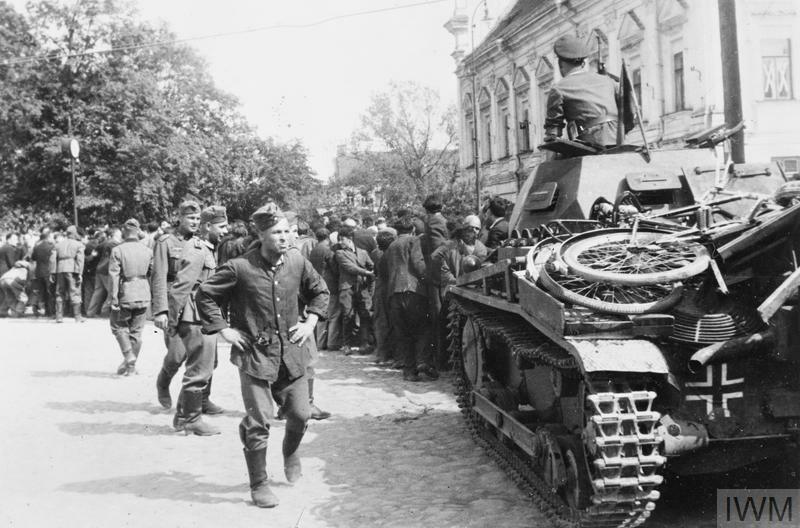
In June 1941, the German army invades Lithuania, which was formerly occupied by the Soviet Union
“On June 22, 1941, the German army, without even declaring war, crossed the border into the Soviet Union, ending their pact of nearly two years….I was thirteen years old and my life, so regular and tranquil until then, had suddenly turned; I could not have anticipated how drastically.”
Jewish men are made to pull a German tank in Kovno (Kaunas) in Lithuania, June 27, 1941.
© IWM HU 8930
Luxembourg
The German army invades Luxembourg in May 1940.
“One Sunday morning Papa and I happened to be walking past the railway station when out of its gates marched columns of German soldiers. Luxembourg now fell under military occupation, but nothing untoward had yet happened.”
Netherlands
The German army invades the Netherlands in May 1940.
“On May 10, 1940, shortly after our visa was denied, German paratroopers landed in Holland. The occupation was swift. Within a few days, the German air force, the Luftwaffe, bombed Rotterdam, our birthplace. The centre of our city was totally destroyed, more than nine hundred people were killed and many were injured. Meanwhile, heavy fighting took place near Arnhem, about a hundred kilometres away, and by May 15 we were under German occupation. We were at war!”
Czechoslovakia
In 1938, Germany gains territory from along Czechoslovakia’s border. The following year, the German army invades the Czech provinces of Bohemia and Moravia, and Slovakia becomes an independent state.
“I was nine years old in 1939 when the German army rolled across the Austrian border into our town. It was a grim day. The scenery was full of armoured trucks, tanks, soldiers in dark green uniforms and the occasional low-flying airplane. With them, the Germans brought their dreadful Nazi ideology.”
Soviet Union
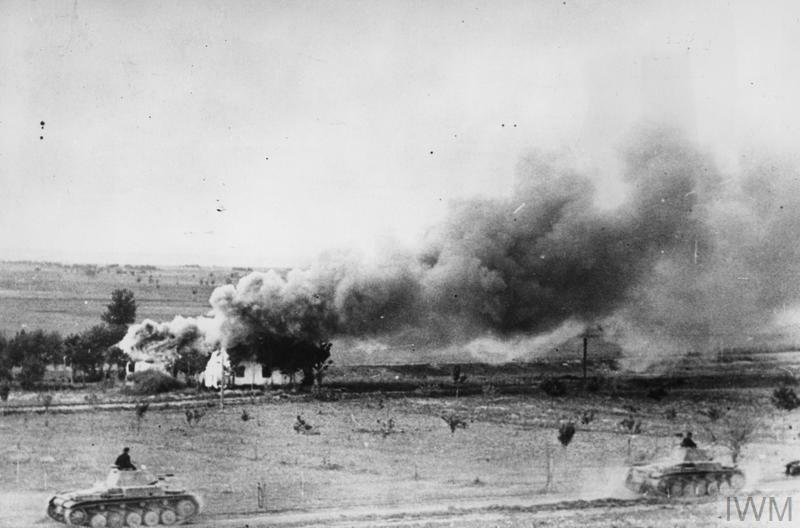
In June 1941, Germany attacks its former ally, the Soviet Union, occupying much of the Soviet Union and the territories it had occupied.
“We had no radio and we received no news from the time the war broke out. When the German forces were passing close to Kortelisy through a little town called Mokrany (Mokran to Jews), many of the Christian Ukrainians from Kortelisy ran to Mokrany to look at and welcome the Germans. They all returned to Kortelisy excited about the Germans and talking about them with admiration: ‘Akh, taki krasyvi, akh khoroshi’—Oh, they are so handsome and so good-looking.”
German tanks pass a burning village in the Soviet Union, summer 1941.
© IWM HU 111382
Romania
In fall 1940, Germany sends military support to the new antisemitic government in Romania, which allies itself with Germany.
“Through that winter and into 1941, a series of restrictions were implemented, and with them came a corresponding escalation of harassment of Jews. The entire atmosphere in town underwent a drastic transformation. Gone were our lovely family parties, spontaneous singing and relaxed strolling in the park. Curfews became mandatory and anyone caught on the street in the evening could be arrested and shot, without even undergoing a trial.”
Belgium
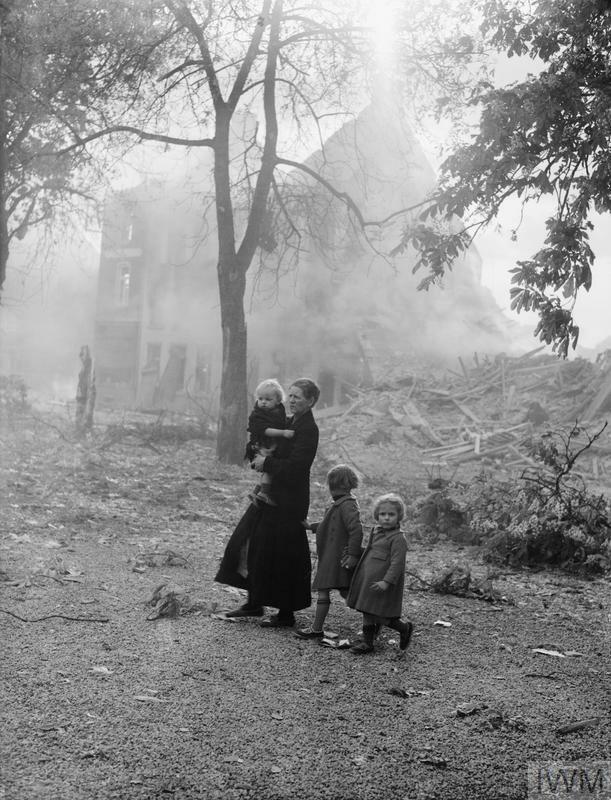
German soldiers march into Belgium in May 1940.
“On the morning of Friday, May 10, 1940, however, I was awakened by the sound of gunfire, and my first reaction was that of a typical child: ‘Oh boy, no school today!’”
A mother and her three children amid the ruins of Enghien, Belgium, May 1940.
© IWM F 4499
Norway
The German army invades Norway in April 1940.
“Norway was ill-prepared for an attack. There were no bomb shelters to speak of, and the air raid sirens that woke us in the middle of the following night caught the population of Oslo by surprise. Although my father knew that the makeshift bomb shelter in the basement of our building would not protect us from a direct hit, he nevertheless insisted that we join the other residents there. It was dark and crowded in the relatively small room, and everyone was nervous and frightened. Our peace had been short-lived. What would become of us? Where could we go?”
Poland

In September 1939, the German army occupies western and central Poland.
“It was a sunny day in ‘golden autumn,’ as we called the season in Poland, when we heard the sound of heavy aircraft. The roar of engines was unusually loud and menacing. We all ran outside the house to look at the sky. Suddenly, darkness spread over us. I felt wrapped in a thick, smoky black cloud…. German troops, who appeared to me to be all the same height, marched triumphantly toward Warsaw, singing.”
German troops march through Warsaw, Poland.
National Archives at College Park, College Park, MD.
Hungary

In March 1944, German forces occupy Hungary, their former ally.
“Our lives immediately and profoundly changed on March 19, 1944…Matters proceeded with lightning speed. Shortly after the German occupation, all Jewish schools had to close their doors. My memories of that time are of constantly worried faces and whispered discussions among the adults around us. The children absorbed their grave concerns by osmosis, and our childhoods were not allowed to blossom as we lived with uncertainty from day to day.”
A roundup of Jews in Budapest by the Hungarian Arrow Cross Party, with the assistance of German police and SS, 1944–1945.
Bundesarchiv, Bild 101I-680-8285A-26 / Faupel.
Germany

In January 1933, Adolf Hitler is appointed head of the German government. In the following months, Hitler and the Nazi Party begin to gain control of Germany through an election and the passing of governmental decrees.
“However, the Nazis did make it to power in 1933. I remember vividly the elections and the Ja (Yes) vote for the Nazis. Nearly everyone on the street sported a glittering silver or brass swastika pin marked with a Ja on their jackets or garments. Since I was one of the very few who was not wearing the Ja pin of national unity and purpose, I stood out. I felt like a stranger in the country in which I was born…”
Hitler watches a procession of the Nazi Party’s armed division, known as the SA Brownshirts or Stormtroopers, in Germany in 1933.
Yad Vashem Photo Archives, Jerusalem. 46765
France

In June 1940, Germany occupies northern France. The rest of the country is occupied in November 1942.
“It was an early afternoon in June, a beautiful month in France, and all the windows were open when we heard a low rumbling coming from [the top of the hill], from the direction of Paris. I ran to the window and saw, coming down the hill, some motorcycles ridden by men wearing goggles. Following them came tanks bearing the dreaded swastikas.”
German soldiers marching through the Arc de Triomphe, occupying Paris, France, on June 14, 1940.
Yad Vashem Photo Archives 1/1/6210.
Lithuania

In June 1941, the German army invades Lithuania, which was formerly occupied by the Soviet Union
“On June 22, 1941, the German army, without even declaring war, crossed the border into the Soviet Union, ending their pact of nearly two years….I was thirteen years old and my life, so regular and tranquil until then, had suddenly turned; I could not have anticipated how drastically.”
Jewish men are made to pull a German tank in Kovno (Kaunas) in Lithuania, June 27, 1941.
© IWM HU 8930
Luxembourg
The German army invades Luxembourg in May 1940.
“One Sunday morning Papa and I happened to be walking past the railway station when out of its gates marched columns of German soldiers. Luxembourg now fell under military occupation, but nothing untoward had yet happened.”
Netherlands
The German army invades the Netherlands in May 1940.
“On May 10, 1940, shortly after our visa was denied, German paratroopers landed in Holland. The occupation was swift. Within a few days, the German air force, the Luftwaffe, bombed Rotterdam, our birthplace. The centre of our city was totally destroyed, more than nine hundred people were killed and many were injured. Meanwhile, heavy fighting took place near Arnhem, about a hundred kilometres away, and by May 15 we were under German occupation. We were at war!”
Czechoslovakia
In 1938, Germany gains territory from along Czechoslovakia’s border. The following year, the German army invades the Czech provinces of Bohemia and Moravia, and Slovakia becomes an independent state.
“I was nine years old in 1939 when the German army rolled across the Austrian border into our town. It was a grim day. The scenery was full of armoured trucks, tanks, soldiers in dark green uniforms and the occasional low-flying airplane. With them, the Germans brought their dreadful Nazi ideology.”
Soviet Union

In June 1941, Germany attacks its former ally, the Soviet Union, occupying much of the Soviet Union and the territories it had occupied.
“We had no radio and we received no news from the time the war broke out. When the German forces were passing close to Kortelisy through a little town called Mokrany (Mokran to Jews), many of the Christian Ukrainians from Kortelisy ran to Mokrany to look at and welcome the Germans. They all returned to Kortelisy excited about the Germans and talking about them with admiration: ‘Akh, taki krasyvi, akh khoroshi’—Oh, they are so handsome and so good-looking.”
German tanks pass a burning village in the Soviet Union, summer 1941.
© IWM HU 111382
Romania
In fall 1940, Germany sends military support to the new antisemitic government in Romania, which allies itself with Germany.
“Through that winter and into 1941, a series of restrictions were implemented, and with them came a corresponding escalation of harassment of Jews. The entire atmosphere in town underwent a drastic transformation. Gone were our lovely family parties, spontaneous singing and relaxed strolling in the park. Curfews became mandatory and anyone caught on the street in the evening could be arrested and shot, without even undergoing a trial.”
Belgium

German soldiers march into Belgium in May 1940.
“On the morning of Friday, May 10, 1940, however, I was awakened by the sound of gunfire, and my first reaction was that of a typical child: ‘Oh boy, no school today!’”
A mother and her three children amid the ruins of Enghien, Belgium, May 1940.
© IWM F 4499
Norway
The German army invades Norway in April 1940.
“Norway was ill-prepared for an attack. There were no bomb shelters to speak of, and the air raid sirens that woke us in the middle of the following night caught the population of Oslo by surprise. Although my father knew that the makeshift bomb shelter in the basement of our building would not protect us from a direct hit, he nevertheless insisted that we join the other residents there. It was dark and crowded in the relatively small room, and everyone was nervous and frightened. Our peace had been short-lived. What would become of us? Where could we go?”